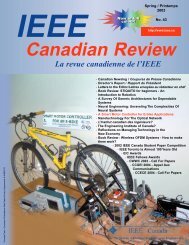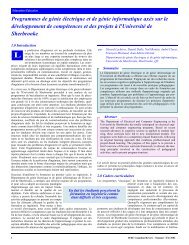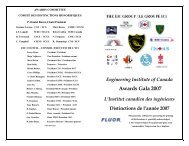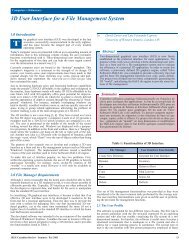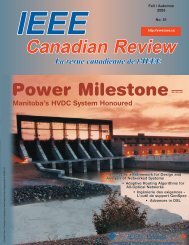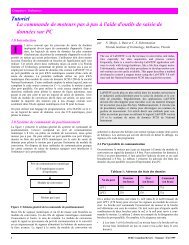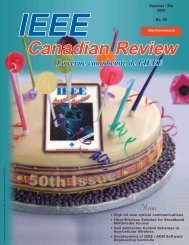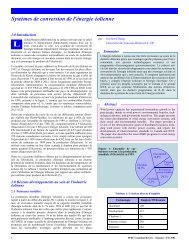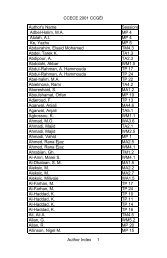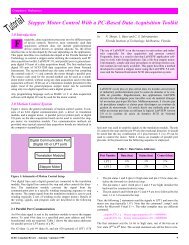Optical Fiber Components Obtained by Refraction Index ... - IEEE
Optical Fiber Components Obtained by Refraction Index ... - IEEE
Optical Fiber Components Obtained by Refraction Index ... - IEEE
You also want an ePaper? Increase the reach of your titles
YUMPU automatically turns print PDFs into web optimized ePapers that Google loves.
type of fiber the gratings has been inscribed on; peak loss position<br />
obtained have varied. It demonstrates that the potential to create better<br />
optical component resides in the exploration and the research of new<br />
types and generation of optical fiber. Therefore <strong>by</strong> using the electric<br />
arc technique it will provide the necessary tool to possibly continue<br />
advancing this technology.<br />
0<br />
-5<br />
Transmission(dB)<br />
-10<br />
-15<br />
-20<br />
-25<br />
-30<br />
-35<br />
-40<br />
0.2 mm<br />
0.3 mm<br />
0.4 mm<br />
1000<br />
1050<br />
1099<br />
1149<br />
1198<br />
1248<br />
1297<br />
1347<br />
1396<br />
1446<br />
1495<br />
1545<br />
1594<br />
1644<br />
1693<br />
Wavelength (nm)<br />
Figure 11. LPFG with different elongation sizes.<br />
expositions of the optical fiber to the electrical arc produce a permanent<br />
and periodic modification of refractive indexes.<br />
The elongation distance is the most important parameter in the fabrication<br />
processes. As shown on the figure below we can produce an LPFG<br />
only with a few elongations if we use the right elongation distance. The<br />
transmission powers are measured for 200µm, 300µm and 400µm elongation<br />
sizes. The exposition duration is about 350ms; the period size is<br />
500µm.The effect of tension on grating formation was also studied in 19 ;<br />
<strong>by</strong> increasing the tension and keeping the arc parameters constant, it is<br />
possible to get higher isolation loss with less discharges although<br />
insertion loss increases. So with these results, we can say that the axial<br />
tension during the LPFG fabrication is favorable to the writing<br />
process. Also, it’s important to say that different tensions during the<br />
writing process produce different resonance wavelengths 19 .<br />
Experimental results have been obtained <strong>by</strong> combining the effects of<br />
electric arc and geometric deformation. The objective was to improve<br />
the quality and the efficiency of producing LPFG using electric arc <strong>by</strong><br />
manipulating other favorable external parameters. In our experiment<br />
we generated a series of electrically tapered grating in effort to analyze<br />
the combined effects on a LPFG. The result shows greater wavelength<br />
isolation was obtain as a result of combining the two effects. Even<br />
though an initial insertion loss was observed, the final result of the<br />
LPFG demonstrated a pronounced wavelength isolation with less<br />
inscriptions.<br />
In general, using the electric arc technique has produced comparable<br />
and useable wavelength isolation as compared to the conventional UV<br />
technique. Cutoff wavelengths with more than 25 db have been produced<br />
within the ranges of 1250 nm and 1600 nm. Depending on the<br />
12<br />
5.0 Prospect<br />
The advantage of this technique resides in the simplicity, flexibility and<br />
adaptability to study new generations of optical fibers. By using the<br />
unique characteristics of these fibers, we can explore and extract properties<br />
that will contribute and aide the progression of the development of<br />
useful optical component. One of the fibers that we are presently working<br />
on includes photonic crystal fibers. The effects of applying an electric<br />
arc across a holey fiber will be examined along with the use of other<br />
external parameter to create a useable optical component.<br />
Another advantage the electric arc technique provides is the ability to<br />
build a self-sustaining optical component-fabricating machine. Instead<br />
of simply buying an electric splicing machine, manufacturers can easily<br />
build a machine that not only splice optical fibers together but produces<br />
custom LPFG as well. This allows producing customized optical components<br />
suiting the user’s needs.<br />
6.0 Conclusion<br />
With the increase of the number of its applications and its fabrication, we<br />
can easily note that the long period fiber gratings are a booming technology.<br />
In addition to reducing the costs and the increase in the fabrication<br />
rate, every new fabrication method provides new types of LPFGs<br />
with new characteristics. Thus, LPFGs that are fabricated with a change<br />
<strong>IEEE</strong> Canadian Review — Spring / Printemps 2006



![Download Presentation [1.9MB PDF] - IEEE](https://img.yumpu.com/51364167/1/190x146/download-presentation-19mb-pdf-ieee.jpg?quality=85)

![Download Presentation [950KB PDF] - IEEE](https://img.yumpu.com/50598566/1/190x146/download-presentation-950kb-pdf-ieee.jpg?quality=85)
